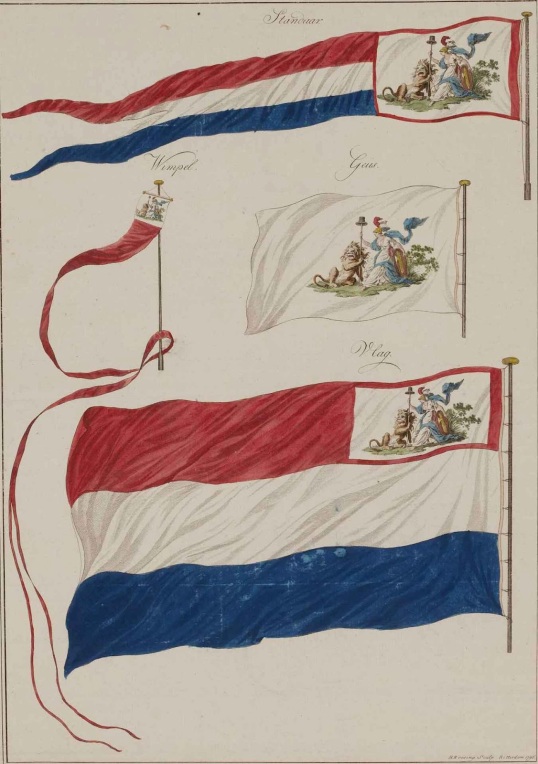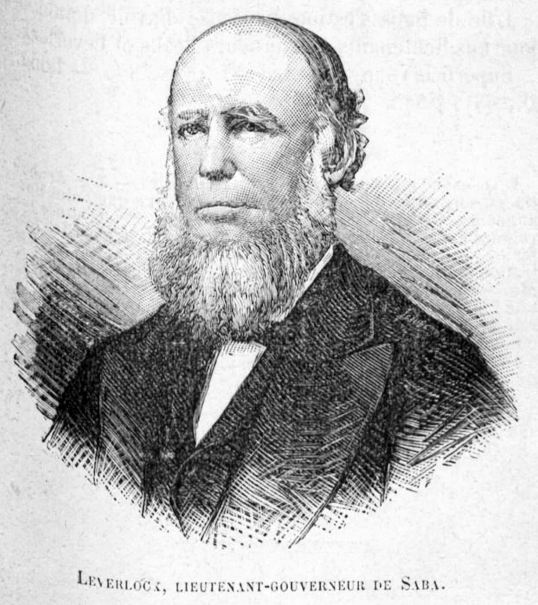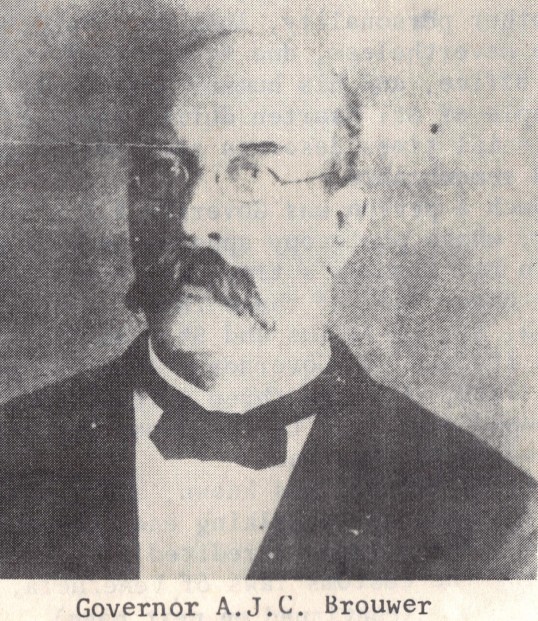The Jews in the Dutch West Indies
THE JEWS IN THE DUTCH WEST INDIES
By; Will Johnson

Various emblems of the Dutch West India Company.
This article alone cannot do justice to the great role played by the Jews in the Dutch West Indies. Much has been written about them by prominent historians. For this article I can only give a brief outline as to why they settled in these islands.
The Iberian Peninsula was captured by the Muslims from Arabia and North Africa shortly after the death of the prophet Mohammed in 1707 and they retained control of what is now Spain and Portugal until 1492 when the last Muslim Prince was forced to abandon his lovely Granada and move over to Morocco. They had been very tolerant to the Jews and the Christians as well during their more than seven hundred years of control of the peninsula. Not so with the Christians. In the same year they sponsored Columbus’ expedition to worlds unknown in the West and came into possession of what later was known as North and South America.
Besides expelling the Moors as they were called, the Christian Kings also expelled the Jews. At the time The Lowlands were under control of the Hapsburg Kings of Austria who later married into the Spanish Royal family. Many of the Jews headed to The Netherlands which included Flanders and Wallonia as well. They were the ones who helped The Netherlands after independence from Spain in 1648 and even before to become a highly successful commercial nation.

Oldest Synagogue in the Americas Mikve Israel (Hope of Israel) in Willemstad Curacao and on the property also a Museum.
When Johannes van Walbeeck and Pierre Le Grand captured Curacao in 1634 they carried a Portuguese Jewish interpreter Samuel Coheno with them who was employed by the West India Company. He was described as a loyal and ingenious man. He remained on Curacao until 1642. Some years later a departure of Jews began to the island. In 1651 the Company granted Joao de Illan (also known as Jeudah de Illan) from Amsterdam permission to carry fifty Jews to Curacao as colonists. The Jewish community in Amsterdam was able to get a passport for some of them. De Illan formed with them a Jewish Community on the island and called it Mikve Israel (Hope of Israel).
A charter granted to David Nassy (also named Joseph Nunes de Foncesca or Cristovao de Tarvora) the following year for settling fifty Jews did not go ahead because of the war between England and Holland. Between 1654 and 1656 however a number of Jews from Brazil came to Curacao via Amsterdam.

S.E.L. Maduro one of the Jewish business pioneers on Curacao.
In 1659 the Company gave Isaac d’Acosta of Amsterdam favorable conditions and privileges to bring Jewish colonists to Curacao. He was able to bring several families consisting of around 70 people. Among the Sefardim who came to Curacao between 1654 and 1675 among others the following families belonged; Alvares Correa, Henriquez, Jesurun, Levy Maduro, Marchena, Henriquez Moron, Namias de Crasto and Pardo, from whom there are still descendants living on Curacao. Because the first Jewish colonists had come out with the orders to go into agriculture, they lived originally outside of the city walls in the Jewish Quarter, where the old Jewish cemetery Beth Haim is located and where they also built a synagogue. Also in town there lived several Jews and they too had a synagogue which in 1674 had to be expanded.

Lovely Penha Building one of the oldest Jewish merchant establishments in Willemstad dating to 1708.
Despite the problems of climate and the land the Jewish colonists dedicated themselves to taking care of their numerous gardens and plantations. The often occurring dry periods were also a reason for them ever since the time of De Illan to become involved in commerce.
They imported finished products from Holland and exported colonial goods which they purchased in the nearby countries. From very early the Jews also owned their own sailing craft; between 1670 and 1900 they owned in total more than 1200. The firm Jesurun alone during the nineteenth century had more than 100 ships in the trade. Many of them sailed to New York and some of them even to Holland. During this period at least 200 Jewish captains stood behind the wheel. Jewish Curacao merchants bought many slaves from the depot of the West India Company which were principally sold to neighboring countries. Philippe Henriquez (Jacob Senior) was a well-known slave trader from the 17th century and empowered by the Admiralty to buy slaves directly from Africa.

Slave ships in the harbour of St. Eustatius.
In the 18th century there was a serious depression, which in 1769 forced the parnassim to introduce a finta (church tax). Twelve of the wealthiest Jews were so strongly opposed to this idea that this plan did not go through until the English occupation. The war of independence of the North American colonies (1775-1781) for that matter had brought with it a revival for the Jewish merchants who sent weapons and food to various Caribbean islands to provision the American rebels. The relationship between the Curacao authorities and the ‘Jewsih Nation’ remained good during this century; often Jews were given official tasks to the neighboring countries. In turn they contributed to the maintenance of the forts, to the leper colony and the insane asylum, the hospital for soldiers and mental patients.
The French interim government on Curacao (1796-1800) and the English occupation were also for the Jews not a favorable time. Just like other islanders the Jews lent large sums of money to the Government of Curacao, which was cut off from The Netherlands. In this same period some of them also took part in the activities of Simon Bolivar whether in his real struggle (Benjamin Henriques as Captain and Juan (Isaac) de Sola as colonel) or otherwise as host of ‘El Libertador’ after his defeat (De Meza), or of his sisters (Mordechay Ricardo). And Luis Brion a national hero of Venezuela alongside Simon Bolivar himself.
Although in the course of time and especially in the economically disadvantaged Curacao in the nineteenth century many Jews moved to elsewhere (St. Thomas, the Dominican Republic, Cuba, Jamaica, Central America, Venezuela, Colombia, and the United States) those who remained were successful in maintaining their considerable social and economic position. Also because of their good schooling – especially German Universities where they went to- twenty years after the Jewish emancipation (1825) Jews occupied several high positions in the colonial government administration. Also in the following centuries the Portuguese Jews were leaders in the banking system and many of them have always been active in the public, intellectual and social life of the island. From a historical perspective there has been a decline which can be proven by figures. Around the year 1700 there were around 1500 members of the Jewish community and in 1983 there were only 275 Sephardic Jews on Curacao. Although small in numbers the ancient Jewish population still plays a prominent role in the economic, social and cultural life of their native Curacao.

An old painting of St. Eustatius
St. Eustatius
It is known that Jews from Curacao visited St. Eustatius from the second half of the seventeenth century – among them a certain David Seraiva in 1660. In the beginning of the 18th century Jewish travelers continued to visit the island. In 1772 there were 21 Jewish resident with 16 slaves. In 1730 the West India Company gave the same rights to Jews as the other island residents, including freedom of religion. In that same year the Jews established their own synagogue which they named Honen Dalim (charitable to the needy) and created a cemetery; the oldest inscription dates from 1742. Seven years later they built a synagogue of which the ruins are still there. Differences of opinion between the Ashkenazim and the Sefardim in 1760 required the intervention of Commander Jan de Windt. During these years Samuel Hoheb was the most outstanding leader of the community. The Jews gave freely contributions Palestinian and other Jewish communities. The great hurricane of August 31st, 1772 obliged them to rebuild their synagogue up from the ground. Of the readers of the community the names of Rabbi Yehezkel (1775) and Jacob Robles (died 1790) remain known.

Ruins of Honen Dalim (1738) synagogue on St. Eustatius. (Charitable to the needy).
The government and people of St. Eustatius gave support to the American rebels. Especially the Jews supplied the American colonists with food and munitions. When Admiral George Rodney and General John Vaughan took over St. Eustatius on February 3rd, 1781, they took money and valuables from the Jews and deported 30 Jewish men to St. Kitts, leaving their ruined families behind.

Remains of the old Jewish Cemetery on St. Eustatius
Many of the deported Jews however returned to St. Eustatius and in 1790 the Jewish community consisted of 190 persons. David Abendanone function then as Chairman and Isaac David Pereira as Treasurer. In that year they paid out more than one thousand pesos in salaries for the Reader for the sexton, to social funds for the poor etc. From 1795 on the Jewish population declined; many immigrated to St. Thomas, Danish West Indies. Between 1850 and 1924 there were never more than three Jews on the island at the same time.
St. Maarten

The Synagogue is supposedly to have been in the back of the Buncamper home at the head of the Front Street in Philipsburg.
In 1735 a Jacob Gomes lived there with his four slaves; besides him the widow Silva with her son and daughter. Already in 1783 there was an organized Jewish community, considering that their Parnassim in that year requested legalization from the West India Company. A synagogue was built on the ‘East end of the Back Street on the South Side.’ M.D. Teenstra around 1828 the ruins of the building. The Jewish population declined since the end of the 18th century. In 1983 there were less than 20 adult Jews on the island, and most if not all of these were from the United States and Curacao. I personally never heard of any local St. Maarten Jew living there.
Saba
In the last years I have done three DNA tests. The first one by the C.I.A. at New York airport. I was pulled aside and taken to a room for interrogation even though I was a Commissioner and Act. Lt. Governor of Saba. I was given the choice of having something looking like flit sprayed in my mouth or for them to take a swab from my mouth. As my flight was about to leave I chose the path of least resistance and let them take a swab from my mouth. At the time I did not even know what a DNA test was.
The second one was my own choice. I thought I was dealing with the National Geographic but it turned out to be a Canadian site. Anyway they concluded that among my other ancestry all from Europe one exception was 7% Berber.
Finally I decided to get one done from the National Geographic. Their conclusion was something like 44% Northern European (U.K. Denmark, Finland, Russia, German), 38% Mediterranean (Iberian Peninsula), 15% Southwest Asia (Persia) and the rest Neanderthal and Denisovan.

Despite its small size people from many nations in the past and now again came to settle here.
I wondered where the 38% Iberian Peninsula had come from. On the Saba population list of 1715 there is a Moise Correa listed with 4 daughters. One of them Rebecca married Peter Simmons the Saba Governor. In my research on my ancestors I am 80% certain that I am descended from this couple. Not only me of course but a number of the Simmons’ also, many of whom left Saba and moved to the United States, Bermuda and elsewhere. Those with Simmons ancestry from Saba are known for their enterprising spirit in whatever field they take on, something which is part of the Jewish heritage. Recently a young man was talking to me. We are related. In our family the women were blonds mostly with Mediterranean skin. We were told that we descended from an Annie Morton. The young man told me that his grandmother had told him that one of our ancestors was from Portugal. I do not know for sure, but Moses Correa had four daughters and perhaps another daughter married into one of the families and she would have been the mysterious Annie Morton. And we continue to try and solve the mystery of our ancestry. Eddie Senior a Jew from an old Curacao family was married to Marie Hughes of Saba and he spent his last years on Saba. When he passed away in his nineties the recently deceased Julio Meit came over from St. Maarten. We churched Eddie in the Roman Catholic Church in Windward Side and he is buried in the church cemetery there. Jews look out for each other it would seem. I remember once a young Jewish soldier came to the Tourist Bureau and asked if there were any Jews living on Saba. I sent him to Eddie’s house and for the next few days I saw Eddy driving the young blond man around. Eddy in his late eighties then was a road runner and I wonder what the young man thought about Eddy driving so fast on Saba’s roads.
There were also Jews on Aruba and Bonaire to a lesser extent, but Jewish names abound in the islands still. Though they are not Jews on the island of St. Eustatius you still find names like Henriquez, Suarez, Lindo, Maduro, Erasmus, Zimmerman, and Simmons and so on. These names came down from after the days of slavery were over. The Jews certainly made their contribution to the Dutch West Indies and are still doing so!
















